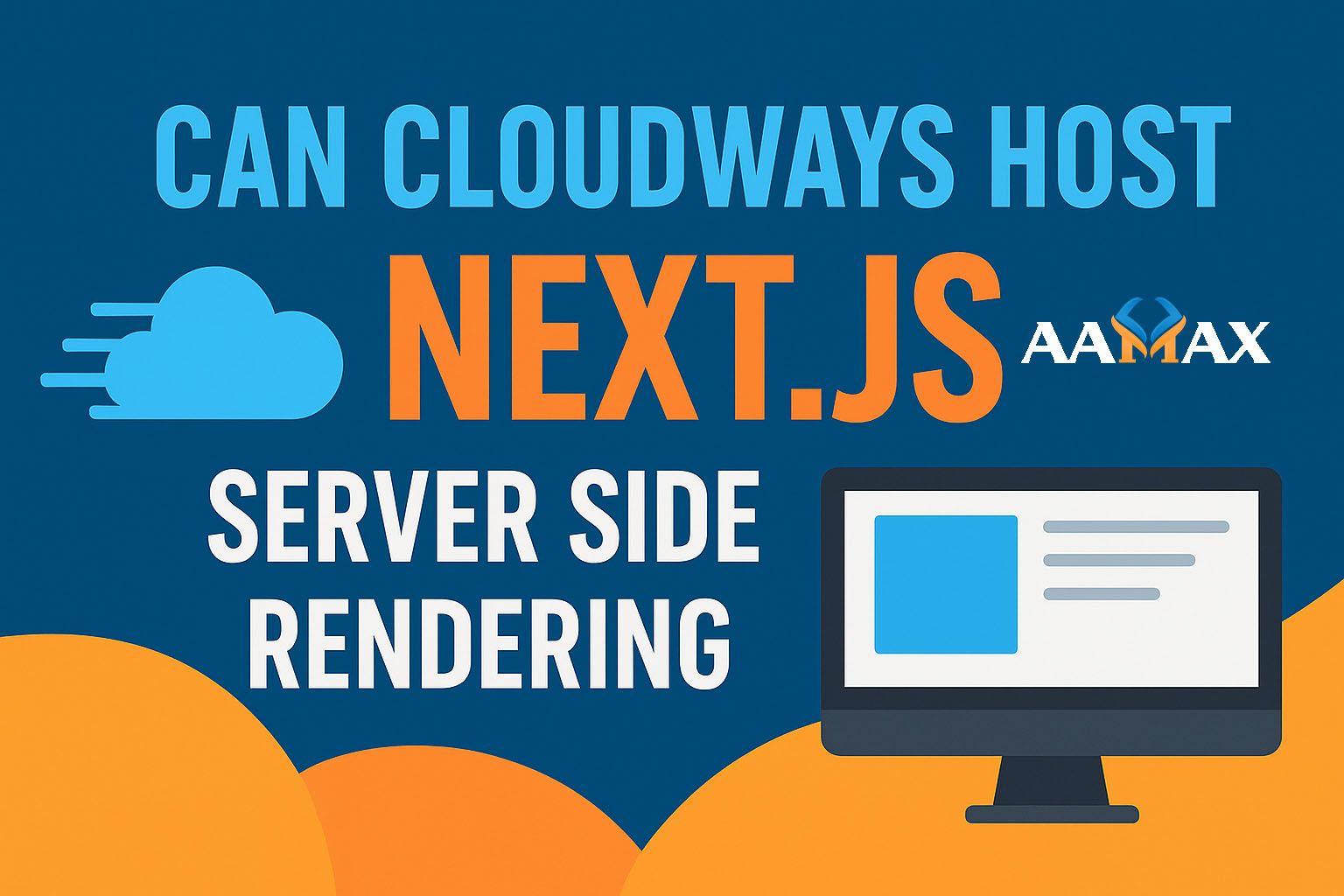
Can Cloudways Host Next JS Server Side Rendering
If you're building a Next.js application and looking for a reliable hosting solution that supports Server-Side Rendering (SSR), you may have come across Cloudways. Known for its flexibility, managed cloud infrastructure, and developer-friendly environment, Cloudways has become a popular choice for hosting modern web applications. But the question remains --- can Cloudways host a Next.js app with server-side rendering?
In this comprehensive guide, we'll dive deep into how Cloudways works with Next.js, its compatibility with SSR, setup steps, performance considerations, and whether it's the right hosting choice for your application.
Understanding Next.js and Server-Side Rendering (SSR)
Before diving into hosting specifics, it's essential to understand what SSR means in the context of Next.js.
Next.js is a React-based framework that simplifies building dynamic web applications. It supports multiple rendering strategies, including:
- Static Site Generation (SSG) -- Pages are pre-rendered at build time and served as static files.
- Server-Side Rendering (SSR) -- Pages are rendered dynamically on the server for every request.
- Client-Side Rendering (CSR) -- Rendering happens on the browser side after fetching the required data.
When you use SSR in Next.js, each page request triggers a server process that fetches data and renders HTML dynamically before sending it to the client. This makes SSR ideal for applications that require real-time content, user personalization, or SEO optimization.
To enable SSR, Next.js needs an environment capable of running a Node.js server --- which brings us to Cloudways.
What is Cloudways?
Cloudways is a managed cloud hosting platform that simplifies deploying and maintaining web applications on leading cloud providers such as:
- DigitalOcean
- AWS (Amazon Web Services)
- Google Cloud Platform (GCP)
- Vultr
- Linode
Instead of managing complex server configurations yourself, Cloudways offers a managed interface that handles updates, monitoring, caching, and security for you. It's often used for WordPress and PHP-based apps, but it also supports custom Node.js applications, which is key for hosting Next.js SSR apps.
Can Cloudways Host Next.js SSR Apps?
Yes, Cloudways can host Next.js applications that use server-side rendering (SSR) --- but with some specific configuration steps.
Cloudways allows developers to deploy custom Node.js applications on any of its cloud providers, giving full control over the backend environment. This makes it compatible with Next.js SSR, since Next.js essentially runs on a Node.js server.
However, Cloudways doesn't provide a one-click "Next.js" setup like Vercel does. Instead, you'll manually deploy your app to a managed Node.js environment. This approach offers more flexibility and scalability, but also requires a bit more technical setup.
Benefits of Hosting Next.js SSR on Cloudways
Hosting an SSR-based Next.js app on Cloudways provides a mix of performance, control, and scalability. Let's explore some key benefits.
1. Full Node.js Support
Cloudways supports custom Node.js servers, meaning you can run your Next.js application directly on your preferred cloud provider. This gives you full access to SSR, API routes, and dynamic rendering capabilities.
2. Choice of Cloud Infrastructure
With Cloudways, you can choose from multiple cloud providers like AWS, DigitalOcean, or Google Cloud. This flexibility lets you control performance, pricing, and geographic distribution.
3. Managed Hosting Simplicity
You get all the benefits of managed hosting --- automatic backups, server monitoring, SSL certificates, and firewalls --- without managing infrastructure manually.
4. Scalability and Performance
Cloudways offers vertical scaling with a single click. As your app grows, you can easily upgrade CPU, RAM, or bandwidth to handle more traffic. Combined with Cloudflare CDN and Varnish caching, performance remains optimal.
5. Secure and Reliable
Every server hosted through Cloudways includes managed security patches, firewalls, and optional SSH/SFTP access. This ensures that your SSR app remains secure against vulnerabilities.
6. Cost-Effective Compared to AWS or Vercel
While AWS and Vercel offer advanced hosting capabilities, they can become expensive as traffic increases. Cloudways provides a cost-efficient alternative, particularly for startups or mid-scale businesses that need strong performance without enterprise-level pricing.
Challenges of Hosting Next.js SSR on Cloudways
While Cloudways is fully capable of hosting SSR applications, there are a few considerations to keep in mind:
1. Manual Setup Required
Unlike Vercel (the creators of Next.js), Cloudways doesn't offer an automated deployment pipeline for Next.js. You'll need to manually configure the Node.js environment, install dependencies, and set up a process manager (like PM2) to keep your app running.
2. No Built-in Git Deployment for Node.js Apps
Cloudways provides Git deployment for PHP apps, but for Node.js, you'll deploy using SSH, Git pull commands, or CI/CD workflows through external tools like GitHub Actions.
3. Performance Optimization Is Developer-Dependent
Since Cloudways gives you full control, optimizing server caching, SSR performance, and CDN integration is your responsibility.
4. Limited Free Tier
Cloudways offers a 3-day free trial, but no permanent free plan. However, it remains affordable compared to AWS or Google Cloud directly.
How to Deploy a Next.js SSR App on Cloudways
Here's a step-by-step guide to hosting a Next.js SSR app on Cloudways successfully.
Step 1: Launch a Server
- Log in to your Cloudways account.
- Click "Launch" to create a new server.
- Choose Custom App (Node.js) from the list.
- Select your preferred cloud provider (e.g., DigitalOcean or AWS).
- Choose your server size and data center region.
- Launch the application.
Step 2: Connect via SSH or SFTP
Once your server is running, connect to it using SSH:
ssh -i your-key.pem master@your-server-ip
Or use the SFTP credentials provided in the Cloudways dashboard to upload files manually.
Step 3: Clone Your Next.js App
You can clone your project directly from GitHub or upload your source files manually.
git clone https://github.com/yourusername/your-nextjs-app.git
cd your-nextjs-app
Step 4: Install Dependencies
Install all necessary packages using npm or yarn.
npm install
# or
yarn install
Step 5: Build and Start the Next.js Server
Next, build your app and start it using Node.js or a process manager like PM2:
npm run build
pm2 start npm --name "nextjs-app" -- run start
This command will keep your application running persistently, even if the server restarts.
Step 6: Configure Environment Variables
Cloudways allows you to set environment variables through its application settings panel. Add variables like:
NODE_ENV=production
NEXT_PUBLIC_API_URL=https://yourapi.com
Step 7: Enable SSL and Domain Mapping
In the Cloudways dashboard:
- Go to the Application Management tab.
- Under Domain Management, add your domain.
- Enable SSL Certificate via Let's Encrypt.
Step 8: Optimize for Performance
For better performance, you can:
- Use a CDN like Cloudflare or BunnyCDN.
- Enable caching for static files.
- Use Next.js Image Optimization (
next/image) with Cloudways CDN integration.
Once everything is configured, your Next.js SSR app will be live and ready to handle production traffic.
Alternatives to Cloudways for Hosting Next.js SSR Apps
While Cloudways is a strong contender, there are other platforms that support SSR more natively:
Platform Pros Cons
Vercel Built for Next.js, Expensive at scale
zero-config
deployment
Render Easy setup, Limited free tier supports SSR
AWS (Elastic Beanstalk) Fully customizable Complex configuration
DigitalOcean App Platform Scalable and fast Limited SSR performance tuning
However, Cloudways remains ideal for developers who want control + managed services without vendor lock-in.
When Should You Use Cloudways for Next.js SSR?
Cloudways is a great choice when you:
- Need server control but prefer managed hosting.
- Want to use DigitalOcean or AWS without configuring them manually.
- Run MERN stack or Node.js applications alongside Next.js.
- Expect moderate to high traffic and want to scale resources easily.
- Want a cost-effective solution compared to enterprise platforms.
If your app heavily relies on SSR and you need full flexibility --- Cloudways offers a sweet balance between control, performance, and affordability.
Why Choose AAMAX for Next.js and MERN Stack Development
If setting up SSR hosting feels complex, or you want to ensure your application runs seamlessly in production, partnering with experts is a smart move. AAMAX is a full-service digital marketing and web development company offering professional MERN Stack Development, Web Development, Digital Marketing, and SEO services.
Here's why businesses trust AAMAX:
- Skilled Developers: Experienced in React, Next.js, Node.js, and MongoDB.
- Optimized Hosting Solutions: Expertise in deploying and managing SSR environments.
- Performance-Driven Approach: Focused on speed, SEO, and scalability.
- End-to-End Service: From concept to deployment, AAMAX covers every aspect of development.
With AAMAX, you can be confident your Next.js SSR app will not only be developed professionally but also hosted and optimized for peak performance.
Final Thoughts
So, can Cloudways host a Next.js application with server-side rendering? Absolutely yes. Cloudways provides everything you need --- from Node.js support to managed infrastructure --- to host, scale, and maintain SSR-powered Next.js apps effectively.
While it requires manual setup compared to Vercel, the tradeoff is greater control, flexibility, and often better cost efficiency. If you want a balance between power and ease of use, Cloudways is an excellent choice for Next.js SSR hosting.
And if you're planning to build, deploy, or optimize a Next.js or MERN stack Development, AAMAX is here to help you every step of the way. From building robust web solutions to optimizing hosting environments, their expertise ensures your digital success.







